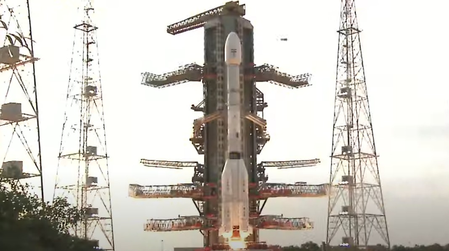
New Delhi, July 30 (IANS) Marking a significant milestone in the India-US partnership, the NASA-ISRO Synthetic Aperture Radar (NISAR) satellite successfully launched on Thursday.
The satellite launched aboard India’s GSLV-F16 rocket from the Satish Dhawan Space Centre, Sriharikota in Andhra Pradesh at 5.40 pm.
“We have liftoff! GSLV-F16 has successfully launched with NISAR onboard,” ISRO said in a post on social media platform X.
“#GSLV-F16 lifts off with the NASA–#ISRO NISAR Earth Observation Satellite,” added Union Minister of State for Science and Technology, Jitendra Singh on X.
About 19 minutes after lift-off, the GSLV-F16 rocket will inject the NISAR satellite into a 743-km sun-synchronous orbit. It is the Geosynchronous Satellite Launch Vehicle’s (GSLV) first launch into a Sun-Synchronous Orbit (SSO).
NISAR is the first joint Earth observation mission between the ISRO and NASA, combining the expertise and synergies of both agencies.
“Go NISAR! The joint NASA-India satellite aboard @ISRO’s Geosynchronous Launch Vehicle launched from the southeast Indian coast at 8:10am ET (1210 UTC) on its mission to monitor Earth’s changing land and ice surfaces,” said NASA on X.
The mission, valued at $1.5 billion, aims to revolutionise the way we monitor Earth’s surface, particularly in tracking natural disasters and environmental changes.
The satellite will provide 24×7 imagery regardless of weather or lighting conditions.
“It can take pictures of the Earth 24 hours a day in all weather conditions and the satellite can detect landslides, aid in disaster management, and monitor climate change,” said Dr. V Narayanan, ISRO Chairman.
Notably, the launch signifies the deepening cooperation between India and the US in the space domain. Following the bilateral Summit of Prime Minister Narendra Modi with President Trump in Washington, DC, in February, both leaders hailed 2025 as a pioneering year for US-India civil space cooperation.
Weighing 2,392 kilograms, the satellite will be inserted into a sun-synchronous orbit at an altitude of 740 km, where it will scan the Earth’s landmass and ice-covered surfaces every 12 days with high-resolution imagery over a 242-kilometre swath, utilising SweepSAR technology for the first time.
NISAR marks the first time the Earth will be observed using dual-frequency Synthetic Aperture Radar. The satellite carries two radars, called the L-band and S-band.
NASA contributed to the L-Band Synthetic Aperture Radar (SAR) — a high-rate telecommunication subsystem, GPS receivers, and a deployable 12-meter unfurlable antenna.
The S-Band SAR payload, the spacecraft bus to accommodate both payloads, the GSLV-F16 launch vehicle, and all associated launch services were developed by ISRO.
Together, these radars will be operated using NASA’s 12-meter unfurlable mesh reflector antenna, mounted on ISRO’s customised I-3K satellite bus.
NISAR would enable continuous monitoring of disturbances in the ecosystem and help assess natural hazards such as earthquakes, tsunamis, volcanic eruptions, and landslides. It will track subtle changes in the Earth’s crust and surface movement.
The satellite’s data will also be used for sea ice classification, ship detection, shoreline monitoring, storm tracking, crop mapping, and changes in soil moisture.
–IANS
rvt/
